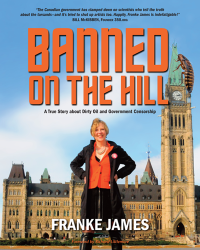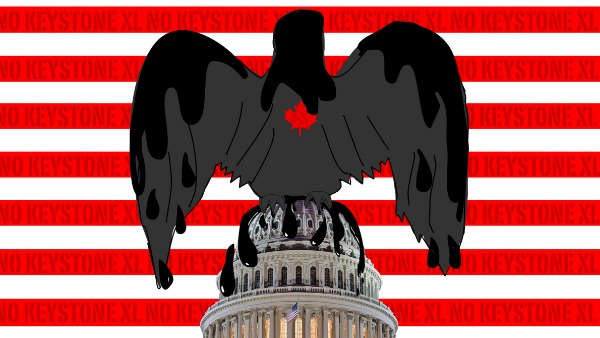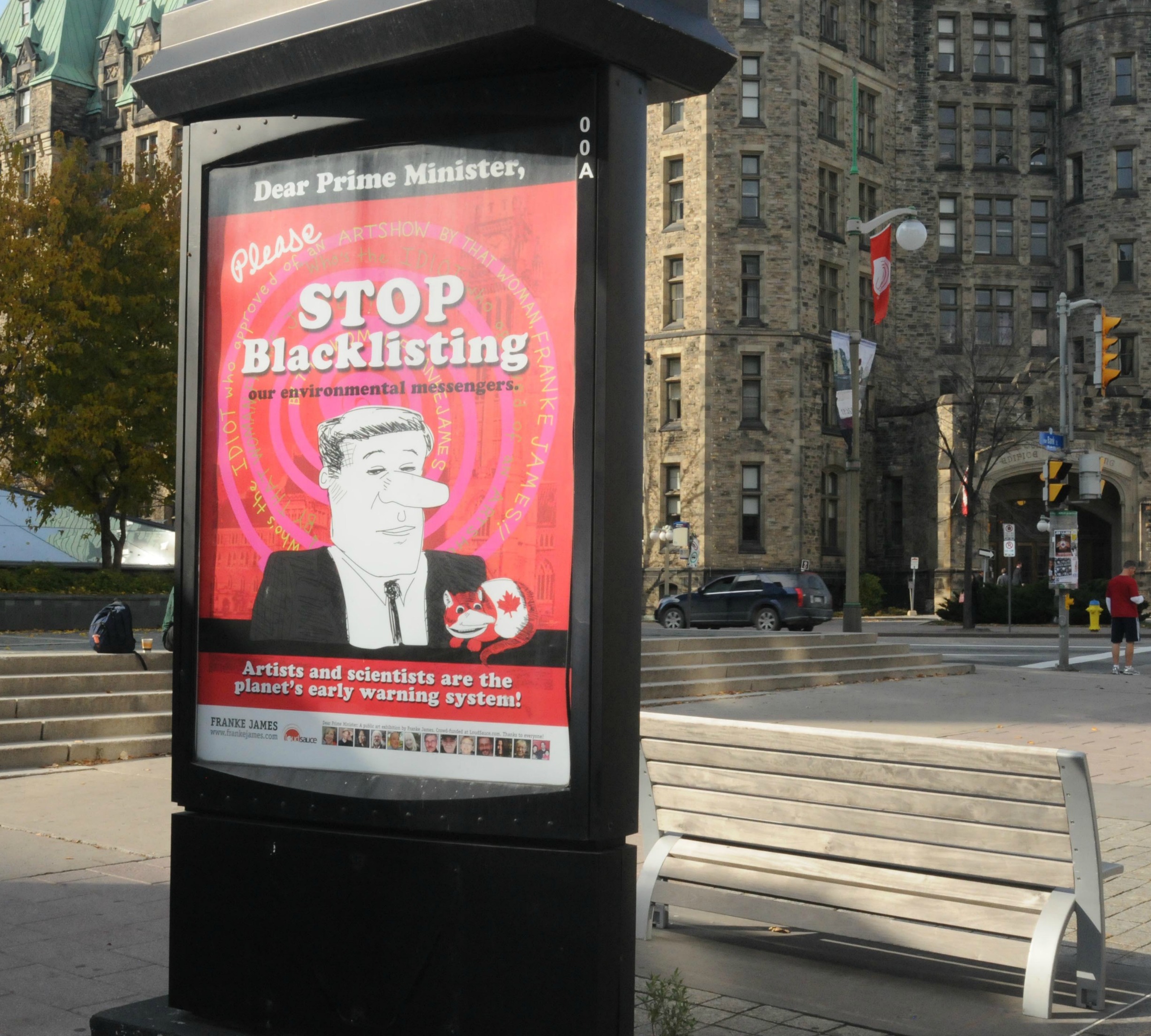
Franke James.
Canadian artist Franke James knows how to convey gloomy information without being a downer. She takes a relentlessly cheerful, self-deprecating approach to issues too often screamed about by scolds and trolls. (It’s an approach we here at Grist admire.) Her illustrated essays call out individuals, corporations, and governments for their inadequate responses to environmental threats, but in an unfailingly good-natured way more likely to make you grin than grimace. Though her art reaches a wide audience, James is no subversive revolutionary; she herself says, “I don’t like to get in trouble for what I do.” So it’s hard to believe the Canadian government would be keeping its eye on her, much less interfering with her work.
In the U.S., Canada, and beyond, environmentalists of all kinds have been the subjects of increased government attention in recent years — especially as opposition to fracking and the Keystone XL pipeline grows more intense. (Earth Island Journal has a great in-depth report on this trend, giving a typical example of how a small and civil local anti-fracking group that strove to avoid inflammatory rhetoric found itself featured in intelligence bulletins compiled by a private security firm and distributed to Pennsylvania state and local authorities.)
 James didn’t know she was on the government’s radar until promised federal funding for a traveling show of her art in Europe was mysteriously yanked, and the Croatian nonprofit organizing the show was pressured to scrap it. By filing Access to Information requests (the same as a U.S. Freedom of Information request) and poring over internal government emails, James discovered that her art, and its criticism of Prime Minister Stephen Harper’s tar-sands-boosting administration, didn’t sit so well with the feds. Her book Banned on the Hill tells the tale as only she can: in a series of illustrated essays, some of which were published a few years ago and cited by bureaucrats in their email exchanges as examples of James’ unacceptable artistic dissent.
James didn’t know she was on the government’s radar until promised federal funding for a traveling show of her art in Europe was mysteriously yanked, and the Croatian nonprofit organizing the show was pressured to scrap it. By filing Access to Information requests (the same as a U.S. Freedom of Information request) and poring over internal government emails, James discovered that her art, and its criticism of Prime Minister Stephen Harper’s tar-sands-boosting administration, didn’t sit so well with the feds. Her book Banned on the Hill tells the tale as only she can: in a series of illustrated essays, some of which were published a few years ago and cited by bureaucrats in their email exchanges as examples of James’ unacceptable artistic dissent.
We caught up with James — whose work has been featured on Grist — to learn what it’s like to be the unlikely target of misplaced government paranoia.
Q. Why do you make art the way you do?
A. There are a lot of people who don’t really like to sit down and read a book, and putting it together the way I [do], with words and pictures, gives a certain amount of fun to it. It makes for a very easy read.
Q. When did you start exploring environmental themes in your work?
A. Going back to 2003, that’s when I started to do [online] political games. My husband and I — he’s an artist and a programmer — we did this crazy “Whack the PM” game for three elections. The challenge was that you were supposed to whack the politician on the head that said the stupidest thing. And by the end of the game you would have decided who you hated the most, and the game helped you to figure out who to vote for.
I didn’t start to do environmental work until 2006. It was triggered by a home renovation that we were doing. I started to look into the whole idea of energy efficiency, and I’m reading all these articles on global warming, going, this is huge! This is the biggest elephant in the room and nobody’s talking about it! I have to tell people! So I started to write really long articles for my blog, but nobody was paying any attention. So in January of 2007, I published my first visual essay that basically was a personal story that talked about climate change. It was called “A Green Winter: Will Global Warming be Good for Canada?” I [had] interviewed Steven Levitt [author of Freakonomics]. I had met him at a conference. I asked him, “How would you tackle global warming?” And he went, “Why would you even worry about it? Global warming is gonna be good for Canada!” And I went, “WHAT!” So that was the beginning of that whole essay.
Q. Tell us about what happened when the government tried to shut you down.
A. Nektarina, [a] Croatian NGO, contacted me in early 2011 and asked if they could buy my art for a touring show in Europe. So I started to get the pieces ready, and then in mid-May, I sensed that we weren’t moving ahead maybe quite as fast as we were supposed to. I asked [Nektarina director Sandra Antonovic] what was going on, and she said that she had gone to the Canadian embassy and asked for a little bit of help — $5,000 in funding. And that she had heard that the grant had been approved, but then it had been cancelled. The cultural officer [at the Canadian embassy in Croatia] told Sandra, “Don’t you know this artist speaks against the Canadian government?” She told Sandra that when Ottawa heard that they were going to support my show in any way, they said, who’s the idiot who approved of an art show by that woman Franke James?
Q. Did you have any idea the government was even aware of you and your art?
A. I had no idea whatsoever. I was just blissfully going along, creating my stuff. I’d done “Whack the PM,” the online election game, and I’d written a letter to the prime minister, but I had no idea that they’d even noticed my work. So I was shocked to hear that they were trying to trip up my art show.
The fact that they were warning the nonprofit not to show my work was just incredible. They really stepped over the line in doing that. It’s one thing not to approve of the grant. But I really didn’t think that bureaucrats would be skulking in the background, warning the show producer not to show my art. When people hear that I didn’t get funded, a lot of people just shrug their shoulders and go, “Well, what do you expect, it’s a petro-state.” But the funding is not the issue, the issue is that they interfered in a private business deal and warned the show producer not to show my art.
Sandra and I thought that the show could still go on, because that $5,000 didn’t make any difference. But they continued to pressure and bully the Nektarina nonprofit. So we ended up cancelling the show in August of 2011.
Q. So what did you do in response?
A. I did two things. I decided, one, I need to file access requests to get the truth. I need to dig for evidence. I need to be able to prove to people that this really happened. In that respect I think that my book could be really useful to people who are putting in freedom of information requests, to see how I did the digging.
And the second thing [I decided was], I better get public about this. I decided to do [an] outdoor poster show on the streets of Ottawa.
Q. What was the process of filing the Access to Information requests like? What did you learn? I thought the section of your book where you detail all the ways government officials cover their tracks and avoid disclosing information was really interesting.
A. I found the whole process to be really fascinating, and in some ways inspiring. Which is exactly what the government didn’t want.
Those documents proved that the government was not telling the truth. Publicly they’d been saying that the funding had never been approved. And then the actual documents, which are in the book [pages 174-5], were able to show that it was approved internally, and then it was killed by the climate change office.
It was a real shocker to get the access documents and see this [one] heavily redacted email thread with the subject line “Franke James is your fault.” To me, [that] is one of the clearest examples of how undiplomatic the diplomats were.

A page from Banned on the Hill with one of the internal government emails James received access to. (Click to embiggen.)
We’ve got the government spokesperson saying internally, “The artist’s work dealt mostly with climate change and was advocating a message that was contrary to government policy.” If art has to agree with government policies, then art equals government propaganda.
Q. What was the response to the poster show like?
A. The response was fantastic. In my campaign, I didn’t limit it just to myself — I said, “Stop blacklisting environmental messengers; artists and scientists are the planet’s early warning system.” Because the Harper government isn’t just silencing me. Anybody who has a dissenting voice and could potentially be off-message from what the government wants to say is being silenced.
Q. Tell me more about what the Harper administration does to quash dissent.
A. In 2007, the Harper government instituted a new communications policy in Environment Canada, which basically said there should be one department, one voice. And so instead of a reporter being able to call up any scientist they want to and speak to them, they had to go through a central source and be approved and have their questions approved, and the process could take weeks, if not months. And this type of message control has been carried beyond Environment Canada to other government departments.
In a private corporation, you could have strict controls about brand messaging, what the company’s message is, what employees are allowed to say, etc. But in a democracy, you don’t expect to assert that type of message control. And I certainly am proving that their muzzling and censorship of me is not working.
I’m really proud that I’ve actually moved people to action. In my book I say that 7,924 letters have been sent to Harper and to the MPs [members of parliament]. I mean, these guys really know who I am now. I’m a thorn in their side.
Q. I’m kind of surprised they didn’t find some way to keep your poster show in Ottawa from happening.
A. I was concerned about that. I wasn’t being specific about when the show was going to take place, or exactly what we were buying or where. If you look back at my tweets from then, I really wasn’t saying very much until the show was actually up. So the government wouldn’t have known why I was going to Ottawa.
Q. You were surprised to find out that you were being watched by the Canadian government. What was your reaction to news of PRISM and the U.S. government’s surveillance of its citizens?
A. I think it’s scary. They will say that it’s just the metadata, but I think that it is beyond that in lots of ways and we’re just not hearing it yet.
I think one problem is that people will look at someone like me, and they’re gonna say, “Franke tells a good story, but I don’t think I want to speak up about climate change because I don’t want to get followed by the government. I don’t want to have them monitoring my phone calls and emails.” So I think that it’s really important for us to step up and say that privacy is important, and that they shouldn’t be treating environmentalists like they’re radicals. Because they’re not. There’s nothing radical about wanting clean air and water. And there’s nothing radical [about] expecting that polluters should pay. And that we should demand accountability and transparency.
Q. What’s next for you?
A. We did the show in Ottawa. The posters are up til the end of June. The big push that I’d like to do now is go to another city. I think the best city would be Washington, D.C. If we went to Vancouver, I’d get a ton of support. Lots of people would be very receptive to the message because they’re really against the pipeline. Calgary, I think I’d probably just get shut out. They’d try to ignore me as much as possible, because it’s really in the heart of the tar sands and the oil industry up there. So I think that Washington is probably the best city to make a difference. I’d like to arrange to have a bit of an art show. Then it brings together the greenwashing of the tar sands, the silencing of environmental voices, and the Keystone XL.
Check out James’ indiegogo campaign to raise money to bring her “Banned on the Hill” poster show to another city — maybe Washington, D.C.!





